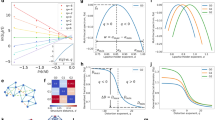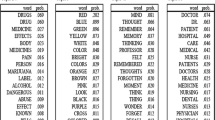Abstract
Although recent research has shown that the complexity of a network depends on its structural organization, which is linked to the functional constraints the network must satisfy, there is still no systematic study on how to distinguish topological structure and measure the corresponding structural complexity of complex networks. In this paper, we propose the first consistent framework for distinguishing and measuring the structural complexity of real-world complex networks. In terms of the smallest d of the dK model with high-order constraints necessary for fitting real networks, we can classify real-world networks into different structural complexity levels. We demonstrate the approach by measuring and classifying a variety of real-world networks, including biological and technological networks, small-world and non-small-world networks, and spatial and non-spatial networks.
Access this chapter
Tax calculation will be finalised at checkout
Purchases are for personal use only
Preview
Unable to display preview. Download preview PDF.
Similar content being viewed by others
References
Boccaletti, S., Latora, V., Moreno, Y., Chavez, M., Hwang, D.U.: Complex networks: Structure and dynamics. Physics Reports 424(4-5), 175–308 (2006)
Keller, E.F.: Revisiting ”scale-free” networks. Bioessays 27(10), 1060–1068 (2005)
Li, L., Doyle, J.C., Willinger, W.: Towards a theory of scale-free graphs: Definition, properties, and implications. Internet Mathematics 2(4), 431–523 (2006)
Bianconi, G.: The entropy of randomized network ensembles. Europhysics Letters 81(2), 28005 (2008)
Claussen, J.C.: Offdiagonal complexity: A computationally quick complexity measure for graphs and networks. Physica A: Statistical Mechanics and its Applications 375(1), 365–373 (2007)
Kim, J., Wilhelm, T.: What is a complex graph? Physica A: Statistical Mechanics and its Applications 387(11), 2637–2652 (2008)
Mahadevan, P., Krioukov, D.V., Fall, K.R., Vahdat, A.: Systematic topology analysis and generation using degree correlations. In: SIGCOMM, pp. 135–146 (2006)
Amaral, L.A., Scala, A., Barthelemy, M., Stanley, H.E.: Classes of small-world networks. Proc. Natl. Acad. Sci. USA 97(21), 11149–11152 (2000)
Goh, K.I., Oh, E., Jeong, H., Kahng, B., Kim, D.: Classification of scale-free networks. Proc. Natl. Acad. Sci. USA 99(20), 12583–12588 (2002)
Maslov, S., Sneppen, K.: Specificity and stability in topology of protein networks. Science 296, 910–913 (2002)
Milo, R., Kashtan, N., Itzkovitz, S., Newman, M.E.J., Alon, U.: On the uniform generation of random graphs with prescribed degree sequences (2004)
Hansen, M.C., Yalcin, H., Hayes, J.P.: Unveiling the iscas-85 benchmarks: A case study in reverse engineering. IEEE Des. Test 16(3), 72–80 (1999)
Kaiser, M., Hilgetag, C.C.: Spatial growth of real-world networks. Phys. Rev. E 69(3), 036103 (2004)
Li, W., Cai, X.: Statistical analysis of airport network of china. Phys. Rev. E 69(4), 046106 (2004)
He, Y., Chen, Z.J.J., Evans, A.C.C.: Small-world anatomical networks in the human brain revealed by cortical thickness from MRI. Cereb Cortex (2007)
Hormozdiari, F., Berenbrink, P., Przulj, N., Sahinalp, S.C.C.: Not all scale-free networks are born equal: The role of the seed graph in ppi network evolution. PLoS Comput. Biol. 3(7) (2007)
Wang, J., Provan, G.M.: Generating application-specific benchmark models for complex systems. In: AAAI, pp. 566–571 (2008)
Wang, J., Provan, G.M.: Topological analysis of specific spatial complex networks. Advances in Complex Systems (in press)
Costa, L., Kaiser, M., Hilgetag, C.: Predicting the connectivity of primate cortical networks from topological and spatial node properties. BMC Systems Biology 1, 16 (2007)
Dambre, J.: Prediction of interconnect properties for digital circuit design and technology exploration. Ph.D. dissertation: Ghent University, Faculty of Engineering (2003)
Kaiser, M.: Brain architecture: a design for natural computation. Philosophical Transactions of the Royal Society A 365, 3033–3045 (2007)
Barthlemy, M.: Crossover from scale-free to spatial networks. Europhysics Letters 63, 915–921 (2003)
Przulj, N., Higham, D.J.: Modelling protein-protein interaction networks via a stickiness index. J. R. Soc. Interface 3(10), 711–716 (2006)
Chung, F., Lu, L.: The average distances in a random graph with given expected degrees. Internet Math. 1, 91–113 (2003)
Ivanic, J., Wallqvist, A., Reifman, J.: Probing the extent of randomness in protein interaction networks. PLoS Comput. Biol. 4(7), e1000114+ (2008)
Friedel, C.C., Zimmer, R.: Influence of degree correlations on network structure and stability in protein-protein interaction networks. BMC Bioinformatics 8, 297+ (2007)
Przulj, N., Corneil, D.G., Jurisica, I.: Modeling interactome: scale-free or geometric? Bioinformatics 20(18), 3508–3515 (2004)
Higham, D.J.J., Rasajski, M., Przulj, N.: Fitting a geometric graph to a protein-protein interaction network. Bioinformatics (2008)
Serrano, A.M., Krioukov, D., Boguna, M.: Self-similarity of complex networks and hidden metric spaces. Physical Review Letters 100, 078701 (2008)
Ma, H., Kumar, B., Ditges, U., Gunzer, F., Buer, J., Zeng, A.P.: An extended transcriptional regulatory network of escherichia coli and analysis of its hierarchical structure and network motifs. Nucleic acids research 32, 6643 (2004)
Castro, J.J., Doyle III, F.J.: A pulp mill benchmark problem for control: Problem description. J. Proc. Cont. 14, 17–29 (2004)
Provan, G.M., Wang, J.: Automated benchmark model generators for model-based diagnostic inference. In: IJCAI, pp. 513–518 (2007)
Author information
Authors and Affiliations
Editor information
Editors and Affiliations
Rights and permissions
Copyright information
© 2009 ICST Institute for Computer Science, Social Informatics and Telecommunications Engineering
About this paper
Cite this paper
Wang, J., Provan, G. (2009). Characterizing the Structural Complexity of Real-World Complex Networks. In: Zhou, J. (eds) Complex Sciences. Complex 2009. Lecture Notes of the Institute for Computer Sciences, Social Informatics and Telecommunications Engineering, vol 4. Springer, Berlin, Heidelberg. https://doi.org/10.1007/978-3-642-02466-5_118
Download citation
DOI: https://doi.org/10.1007/978-3-642-02466-5_118
Publisher Name: Springer, Berlin, Heidelberg
Print ISBN: 978-3-642-02465-8
Online ISBN: 978-3-642-02466-5
eBook Packages: Computer ScienceComputer Science (R0)




